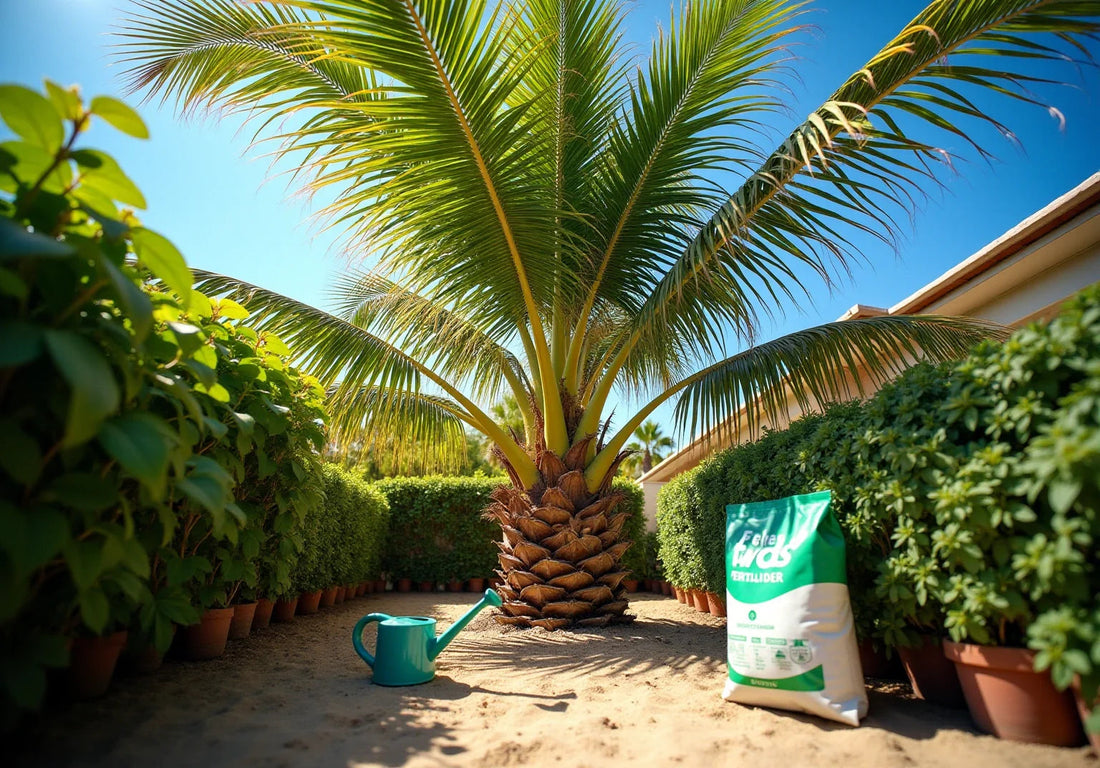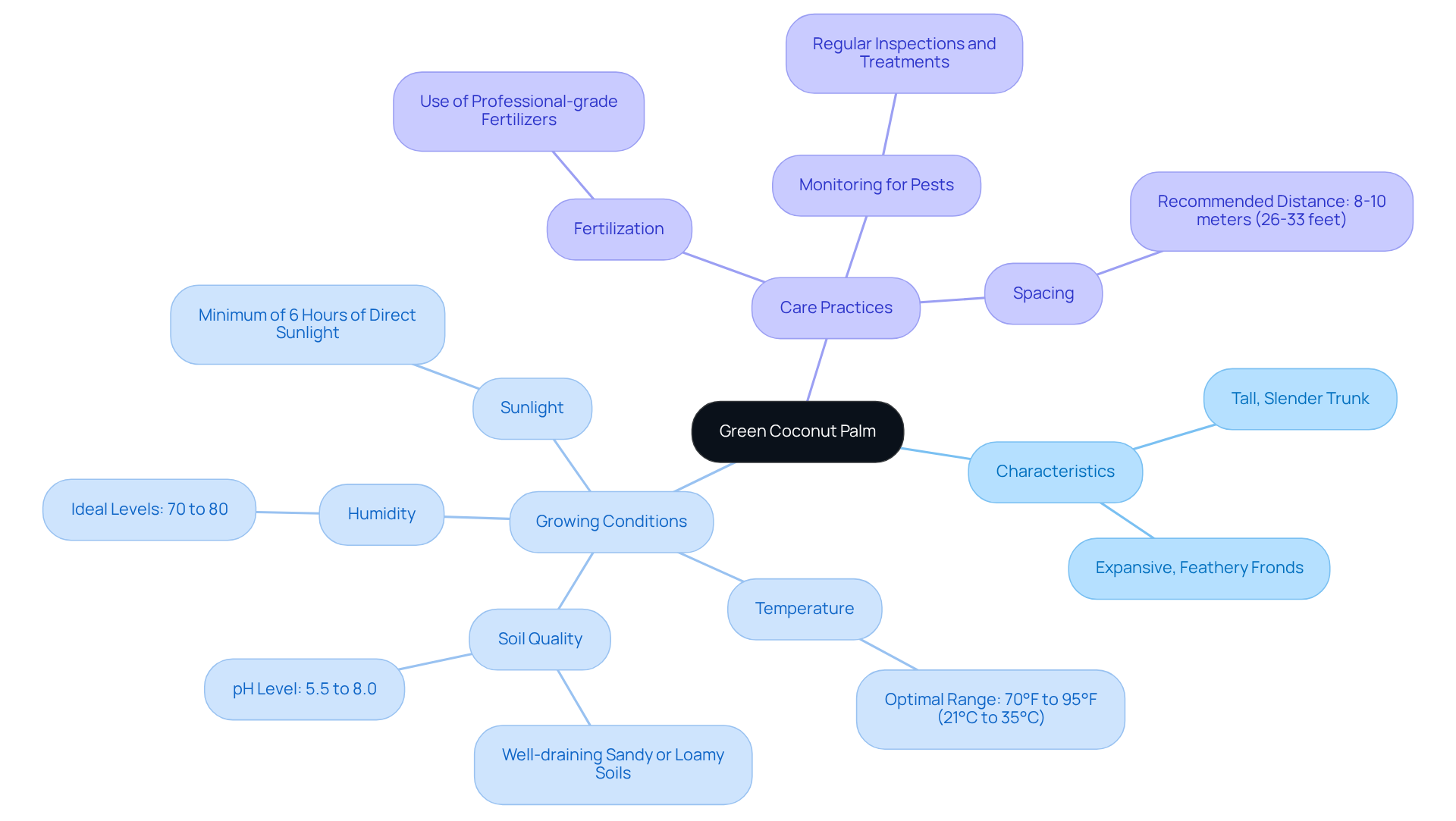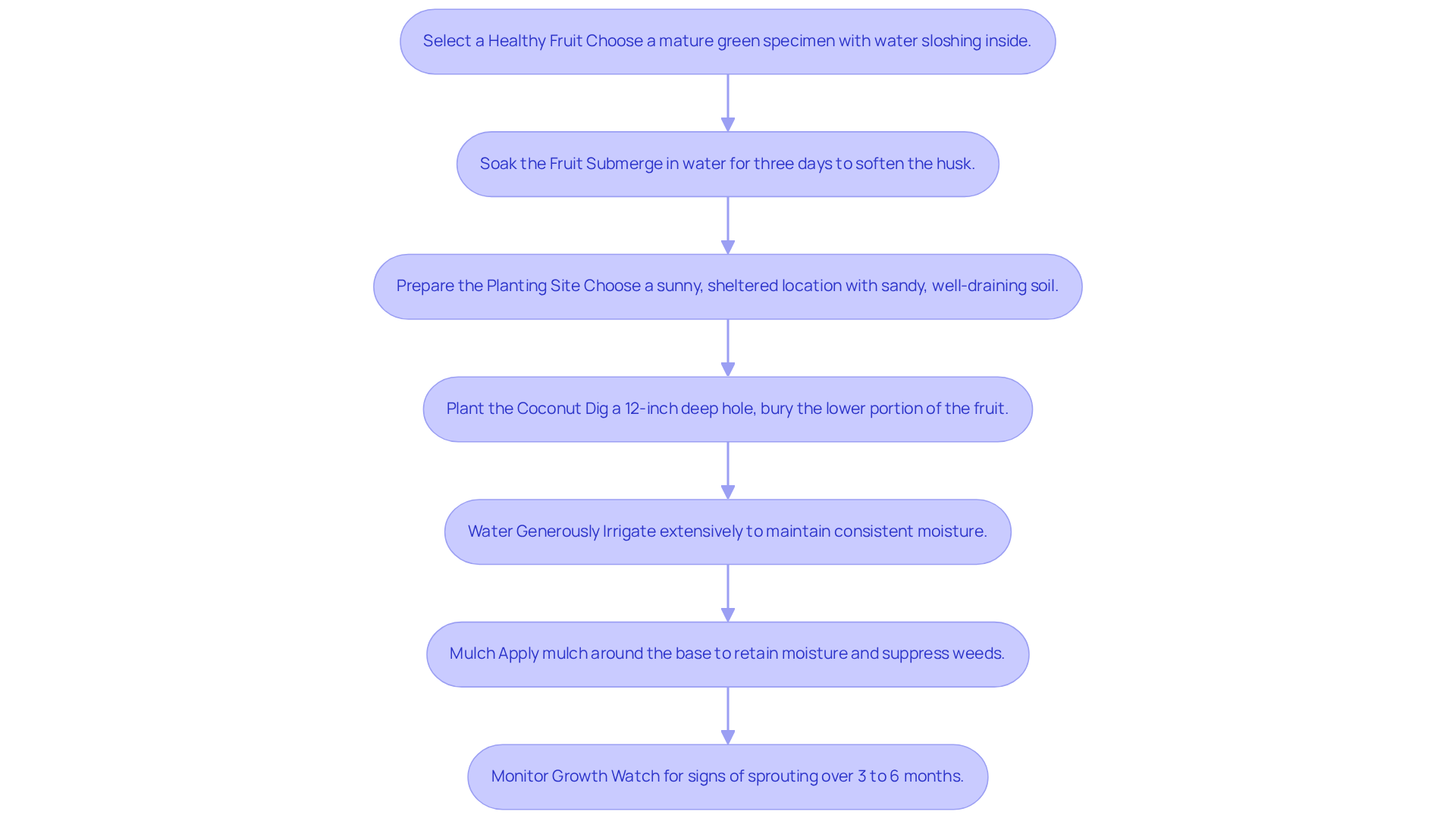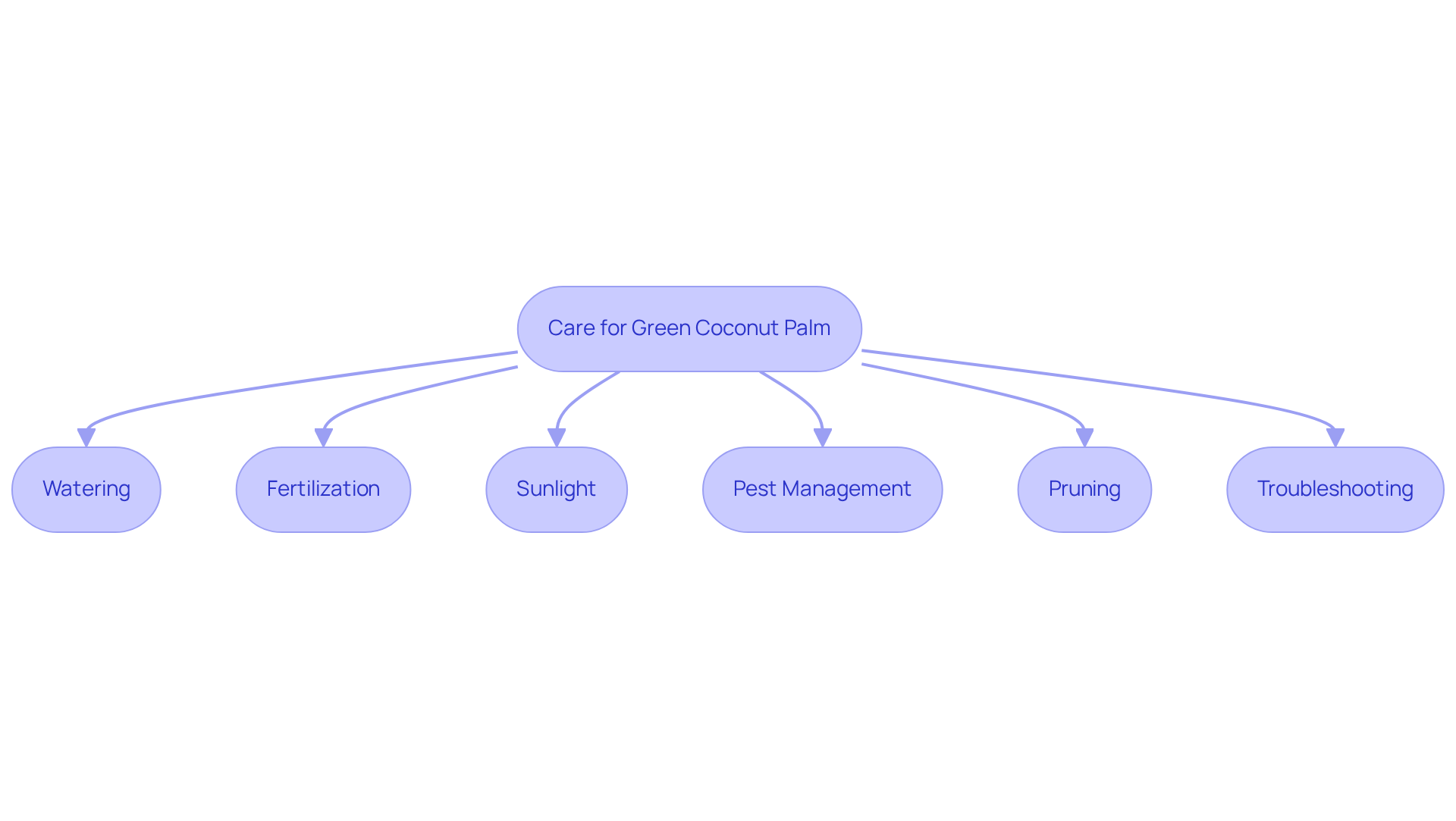
Master the Green Coconut Palm: Planting and Care Steps
Share
The allure of the green coconut palm, often referred to as the 'tree of life', extends beyond its striking appearance; it embodies a wealth of benefits that can transform any garden into a tropical paradise. This guide explores the essential steps for successfully planting and nurturing this magnificent palm, ensuring it thrives in optimal conditions.
However, given its specific growth requirements and potential challenges, such as pests and nutrient deficiencies, how can gardeners ensure they cultivate a healthy and fruitful green coconut palm?
🌴 Want to grow Green Coconut Palm in your garden?
Explore Green Coconut Palm at Everglades Farm - shipped directly from Florida.

Understand the Green Coconut Palm: Characteristics and Growing Conditions
The green coconut palm (Cocos nucifera) is a striking tropical tree recognized for its tall, slender trunk and expansive, feathery fronds. Flourishing in USDA Hardiness Zones 10B-11, this palm thrives in warm temperatures ranging from 70°F to 95°F (21°C to 35°C). It requires well-draining sandy or loamy soils with a pH between 5.5 and 8.0, making soil quality essential for its development. Additionally, the green coconut palm requires a minimum of six hours of direct sunlight each day and thrives in high humidity levels, ideally maintained between 70% and 80%. These specific growth requirements are vital for creating an environment that promotes healthy growth and fruitful production.
With proper care and attention to these conditions, including the use of Everglades Farm's professional-grade fertilizers, gardeners can successfully cultivate this versatile species. Often referred to as the 'tree of life' due to its numerous uses and benefits, the green coconut palm provides a wealth of advantages. To mitigate potential challenges such as pests and diseases, it is important to monitor the palm regularly and apply appropriate treatments as needed. Furthermore, proper spacing of 8-10 meters (26-33 feet) apart is recommended for optimal growth.
Everglades Farm offers a variety of Fast-Growing Trees, featuring the green coconut palm, enabling home gardeners to experience quick-yield tropical greenery in their own backyards. By understanding the specific needs and care practices for this palm, gardeners can ensure a thriving and fruitful addition to their landscape.

Plant Your Green Coconut Palm: Step-by-Step Instructions
-
Select a Healthy Fruit: Choose a mature green specimen that has water sloshing inside, indicating freshness and viability. It is important to note that there is a wide variation in germination time among cultivated varieties and wild specimens, ranging from 30 to 220 days. Thus, selecting a healthy specimen is crucial for successful planting.
-
Soak the Fruit: Submerge the fruit in water for three days to soften the husk, which aids germination. This step is essential, as the germination process can take between 60 to 220 days, influenced by genetic and environmental factors.
-
Prepare the Planting Site: Choose a location that receives full sunlight and is shielded from strong winds. Ensure the earth is sandy and well-draining, as the optimal temperature for growth and fruit production of palm trees is between 27 to 32 °C.
-
Plant the Coconut: Dig a hole about 12 inches deep. Position the fruit on its side, burying the lower portion in the ground while leaving the upper half uncovered. This allows for proper air circulation and moisture retention, which is vital for the germination process.
-
Water Generously: After planting, irrigate the palm extensively to settle the earth around it. Maintain consistent moisture, ensuring the soil is damp but not waterlogged. Adequate watering is essential, particularly given that 50-70% of cultivated trees are beyond their production peak age, emphasizing the significance of caring for young plants.
-
Mulch: Apply a layer of mulch around the base to retain moisture and suppress weeds. This practice helps create a favorable microenvironment for the palm tree.
-
Monitor Growth: Keep an eye on the fruit for signs of sprouting, which can take 3 to 6 months under optimal conditions. Understanding the unique germination process of coconut seeds, which does not conform to standard definitions, can help you anticipate the growth stages more effectively.

Care for Your Green Coconut Palm: Maintenance and Troubleshooting Tips
-
Watering: It is crucial to maintain consistent moisture in the ground, particularly in the early months following planting. Thoroughly water the tree once a week, adjusting the frequency based on rainfall and humidity levels. Green coconut palms generally require 15-30 gallons of water daily for optimal fruit yield, especially during their fruit production, so ensure the soil remains damp but not waterlogged.
-
Fertilization: To support robust growth and enhance fruit yield, apply a palm-specific fertilizer that is rich in potassium, magnesium, and iron every 2-3 months. A granular fertilizer with a 2-1-1 ratio is recommended, incorporating both slow-releasing and fast-releasing nitrogen to meet the tree's varying nutrient requirements. Additionally, granular applications should be performed every three to four months to prevent nutrient deficiencies.
-
Sunlight: Ensure your green coconut palm receives at least six hours of direct sunlight each day. For indoor cultivation, position it near a south-facing window or utilize grow lights to guarantee adequate light exposure.
-
Pest Management: Regular inspections for pests such as spider mites and aphids are essential. If infestations occur, treat them with insecticidal soap or neem oil, both of which are effective natural remedies. Proactive pest management is crucial for maintaining the health of your green coconut palm tree.
-
Pruning: The green coconut palm requires trimming away any dead or yellowing fronds to encourage new growth and enhance the tree's appearance. It is important to avoid cutting healthy fronds, as they play a vital role in photosynthesis and overall plant health.
-
Troubleshooting: Yellowing leaves may signal overwatering or nutrient deficiencies; adjust your watering practices accordingly and consider applying a balanced fertilizer. If fronds are browning, ensure the palm is receiving sufficient sunlight and humidity, as these factors are essential for its health.

Conclusion
Successfully cultivating the green coconut palm necessitates a comprehensive understanding of its specific requirements and appropriate care practices. This tropical tree, renowned for its versatility and numerous benefits, flourishes under optimal conditions, making it a valuable addition to any garden. By adhering to the detailed steps outlined in this guide—from selecting the healthiest fruit to maintaining ideal growth conditions—gardeners can ensure a thriving green coconut palm.
Key insights from this article underscore the significance of proper planting techniques, consistent watering, and diligent pest management. The green coconut palm flourishes in well-draining soil, abundant sunlight, and high humidity, requiring regular attention to these elements for successful growth. Furthermore, employing suitable fertilizers and monitoring for signs of distress will aid in maintaining the palm's health and productivity.
Embracing the journey of planting and nurturing a green coconut palm not only enhances gardening skills but also contributes to a vibrant landscape. Engaging with this tropical beauty can inspire a deeper appreciation for nature and its resources. For those prepared to embark on this rewarding endeavor, the green coconut palm serves as a testament to the joys of gardening and the abundant rewards it can yield.
Cultivate Your Tropical Paradise Today!
Start your journey with Everglades Farm and grow your own green coconut palm effortlessly.
Frequently Asked Questions
What is the scientific name of the green coconut palm?
The scientific name of the green coconut palm is Cocos nucifera.
In which USDA Hardiness Zones does the green coconut palm thrive?
The green coconut palm thrives in USDA Hardiness Zones 10B-11.
What temperature range is ideal for growing the green coconut palm?
The ideal temperature range for growing the green coconut palm is between 70°F to 95°F (21°C to 35°C).
What type of soil does the green coconut palm require?
The green coconut palm requires well-draining sandy or loamy soils with a pH between 5.5 and 8.0.
How much sunlight does the green coconut palm need daily?
The green coconut palm requires a minimum of six hours of direct sunlight each day.
What humidity levels are ideal for the green coconut palm?
The green coconut palm thrives in high humidity levels, ideally maintained between 70% and 80%.
What spacing is recommended for planting green coconut palms?
It is recommended to space green coconut palms 8-10 meters (26-33 feet) apart for optimal growth.
What are some benefits of the green coconut palm?
The green coconut palm is often referred to as the 'tree of life' due to its numerous uses and benefits.
How can gardeners mitigate challenges like pests and diseases when growing green coconut palms?
Gardeners can mitigate challenges by regularly monitoring the palm and applying appropriate treatments as needed.
Where can gardeners find fast-growing green coconut palms?
Everglades Farm offers a variety of Fast-Growing Trees, including the green coconut palm, for home gardeners.

